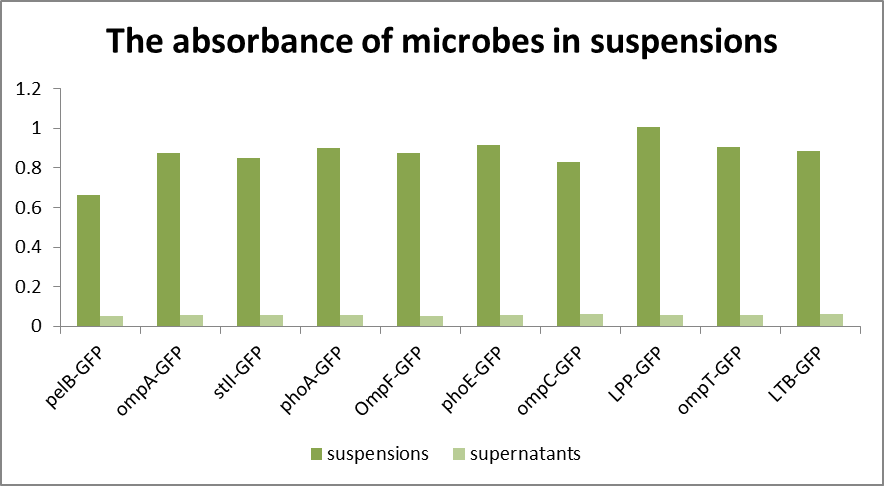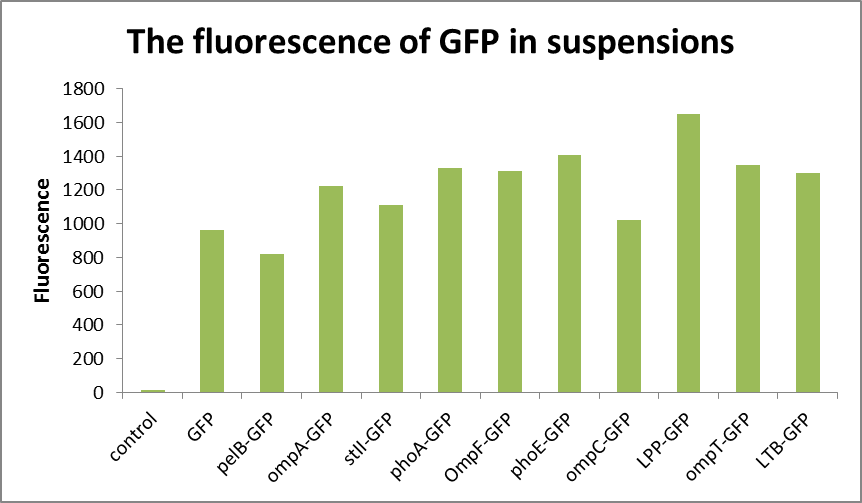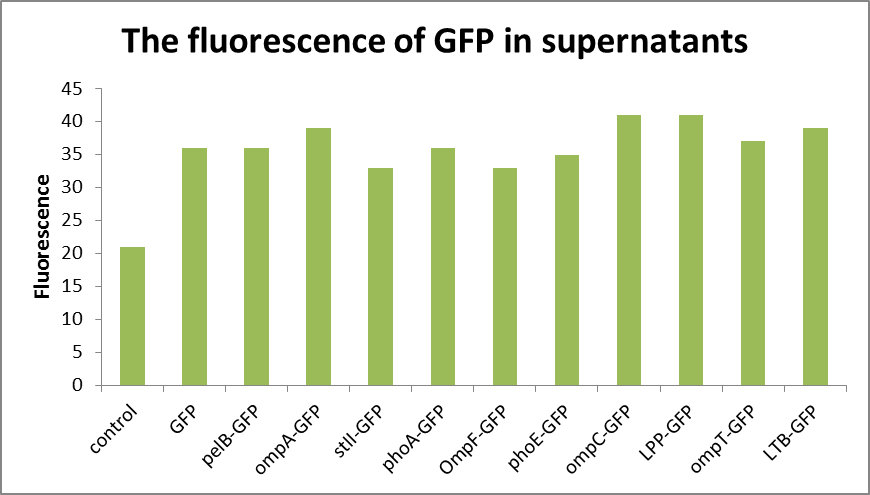Part:BBa_K2273055
PhoA signal peptide of B. subtilis alkaline phosphatase A
The PhoA signal peptide is part of the Signal Peptide Toolbox of [http://2017.igem.org/Team:TU_Dresden iGEM Team TU Dresden 2017 (EncaBcillus - It's a trap!)].
The signal peptide (amino acids 1 to 31) of Bacillus subtilis alkaline phosphatase A (aquisition of phosphate upon phosphoate starvation, Uniprot [http://www.uniprot.org/uniprot/P19406 P19406]) targets for protein secretion via the Sec-SRP secretion pathway (Brockmeier et al, 2006).
This part was generated in a modified version of RFC25, where a strong Shine Dalgarno Sequence (SD) is included, and has the following prefix and suffix:
| Prefix with | EcoRI, NotI, XbaI and SD | 5'-GAATTCGCGGCCGCTTCTAGATAAGGAGGTCAAAA-3' |
| Suffix with | AgeI, SpeI, NotI and PstI | 5'-ACCGGTTAATACTAGTAGCGGCCGCTGCAGA-3' |
Sites of restriction enzymes generating compatible overhangs are indicated by sharing one color. (EcoRI and PstI are marked in blue, NotI in green, XbaI and SpeI in red and AgeI in orange. Additionally, the Shine-Dalgarno sequence is marked in silver and the stop codon is underlined.)
This part is used in the 2017 TU Dresden iGEM project [http://2017.igem.org/Team:TU_Dresden EncaBcillus - It's a trap!] and part of the Signal Peptide Toolbox.
Signal Peptide Toolbox
The GRAM-positive model organism B. subtilis is considered a perfect host for heterologous and recombinant protein secretion due to its extracellular chaperones, natural protein secretion capacity and well-studied genetics (van Dijl and Hecker, 2013). To increase protein production rates of such proteins, it is feasible to enhance the secretion efficiency. The easiest method to realise this, is to tag the protein of interest with a so-called signal peptide of B. subtilis' general protein secretion pathway Sec-SRP which dictates the secretion of proteins into the surrounding supernatant of the cell (Fu et al, 2007).
Though the Sec-SRP protein secretion pathway of B. subtilis contains more than 170 distinct signal peptides, every single signal peptide varies in its secretion efficiency in dependency on the protein fused to it. To date, it is impossible to predict this dependency via studying the genetic code of the signal peptides and the protein of interest (Brockmeier et al, 2006).
To cope with this issue, the [http://2017.igem.org/Team:TU_Dresden iGEM team of TU Dresden 2017 (EncaBcillus - It's a trap!)] developed a novel shotgun approach high-throughput signal peptide screening vector system for targeted secretion in B. subtilis, or âSignal Peptide Toolboxâ for short.
The Signal Peptide Toolbox contains the so-called Evaluation Vector and the Signal Peptide Mix which is made of equal amounts of all signal peptides which are part of the Signal Peptide Toolbox. It can be used by any team to increase secretion efficiency of heterologous and recombinant proteins in B. subtilis.
The iGEM team TU Dresden 2017 provides an Evaluation Vector construct with an inducible promotor. Nonetheless, the vectors' promotor can still be replaced easily.
For screening, in a first step, the coding sequence of the protein of interest as well as a promotor of choice would be cloned into the Evaluation Vector. In a second step, all signal peptides of the Signal Peptide Mix would be integrated into the vector at once. Finally, the randomly transformed bacteria colonies are screened for their specific secretion efficiency using a protein of interest specific assay. Those strains, which reassemble the secretion level of choice the best, can then be sequenced to reversely identify the integrated signal peptide. This process is shown in the following video.
The following list of signal peptides gives an overview of all signal peptides which are currently part of the Signal Peptide Mix of the Signal Peptide Toolbox.
Shanghai_City 2019âs characterization
Usage and Biology
BBa_K2273055 PhoA signal peptide of B. subtilis alkaline phosphatase A
Methods:
1. 20 bacteria culture 20ul were absorbed and put into the microtitration plate.
2. Entrifuge the remaining bacteria solution at 12000g for 1 min.
3. Draw 20ul of supernatant from 20 bottles after centrifugation and put it into the microtitration plate.
4. Put the plate into the instrument to measure the absorbance and fluorescence.
Results:
As can be seen from Fig1, the absorbance of the bacterial solution is generally higher than that of the supernatant, while the fluorescence measurement shows that the value of the supernatant is relatively small, generally 30-40, compared with the value of about 1000 of the bacterial solution(Fig2 and Fig3). The fluorescence of phoA-GFP was higher than the control. It turned out that the protein phoA-GFP was expressed successfully and secreted to the extracellular environment.
the low fluorescence of supernatant indicates that E. coli can only secrete a small amount of fluorescent substances to the extracellular environment. And liken to the control group, it is easy to confirm the specific amount of fluorescent substances secreted.
Sequence and Features
The DNA sequence of this part has been verified via sequencing before it was sent in.
- 10COMPATIBLE WITH RFC[10]
- 12COMPATIBLE WITH RFC[12]
- 21COMPATIBLE WITH RFC[21]
- 23COMPATIBLE WITH RFC[23]
- 25COMPATIBLE WITH RFC[25]
- 1000COMPATIBLE WITH RFC[1000]
//chassis/prokaryote/bsubtilis
| None |




